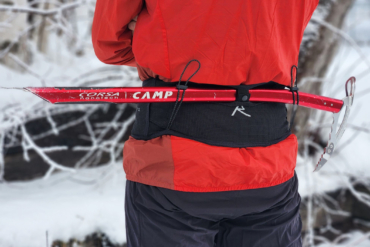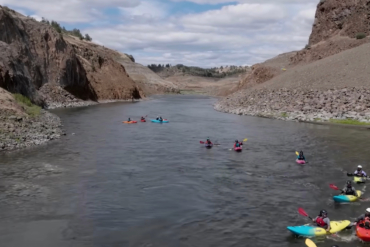Two kayakers repeatedly paddled 18 hours straight, survived everything from lightning storms to mosquito clouds, and crushed the Yukon 1000 course record in a grueling, team-driven effort.
The Yukon 1000 carves deep into the history of its namesake Canadian territory. When Skookum Jim Mason, Dawson Charlie, and George Washington Carmack found gold in a tributary of the Yukon River in August 1896, they had no idea what would come next — except an adventure.
Legend only knows how long it took the three explorers to cover the 1,000 miles from the Yukon to the Arctic Circle. But two paddlers recently knocked it out faster than anyone ever before.
On July 7, Jason Magness and Daniel Staudigel pulled past the finish line at Alaska’s Dalton Highway Bridge after 5 days, 11 hours, and 48 minutes in their kayaks. For the armchair mathematicians, that’s an average of almost 200 miles per day.
Thanks to their blistering pace, Magness and Staudigel carved a massive 15 hours off the overall course record.
View this post on Instagram
“It’s a grind,” Magness said. “I mean, you’re spending 18 straight hours in your kayak, paddling the entire time. And that’s not to mention anything nature’s throwing at you.”
Along the way, the two kayakers overcame frightening weather conditions, wildfire smoke, navigational hazards, and, of course, massive fatigue and pain to capture the record.
Yukon 1000 Navigation: Not Just a Float Trip
The Yukon 1000 course is famously remote. As the website says, a “digital detox,” the race plunges entrants into deep wilderness without satellite navigation or other creature comforts. Paddlers must use only a prescribed, strictly limited kit during the race. And the race directors only offer support in the form of boat repairs and rescues.
You might not think navigation would be that difficult, paddling one way down a river. But think again — the Yukon River is far from a straightforward water course.
Magness and Staudigel used an iPhone GPS (within the rules) to track their location. That worked well for about the race’s first half until they encountered less-charted territory and a broad, heavily swollen floodplain.
“In the first half of the race, there are probably 100,000 data points, so you can use those to chart out your course and then consider river (current) speed to make a plan,” Magness said.
“But in the Yukon Flats, the river is changing all the time. Sand bars get really frequent, and there are super-shallow sections. So the utility just drops off. You can zoom in, and you’ll be somewhere in this huge blue section, where green blobs sort of correspond to islands. But half the time, we’re paddling, and it’s telling us we’re on land.”
Teamwork Makes the Dream Work
Magness is not a stranger to finding his way through uncharted territory. As one of the proprietors of Oregon’s Bend Racing, he and his cohort frequently find themselves navigating adventure races. He and his wife Chelsey won the 5-day Endless Mountains race a week before the gun sounded at the Yukon 1000.
Staudigel, also with Bend Racing, is no slouch either. He finished first at Expedition Canada, a 6-day race, 2 weeks before the record-shattering paddle. Throughout the years, he and Magness have frequently raced alongside each other, generating a special rapport.
“Our background made it so we weren’t really phased by things that other teams struggled with, like sitting in a boat for 24 hours at a time,” Magness said.
“The suffering was on a level of stuff that we’ve suffered in many ways over many years. So that allows Dan and I to get into this really weird headspace of ‘Can the next paddle stroke be better than the last one?’ And just getting into that repetitive form for hours and hours on end.”

Conditions on the Yukon Course
Magness’ description of the action on the Yukon 1000 course could accurately be summed up as “grueling.” Hand, shoulder, and foot pain proved constant — in fact, Magness was just beginning to recover feeling in his fingers and toes a week out from the race.
And on speed attempts, sleep deprivation is a given. Two hundred miles per day do not paddle themselves. Racers must stop for 6 hours a night per race regulations, but it can’t all be sleep for teams on tight schedules.
Because Magness and Staudigel wanted to waste zero possible race time, they jam-packed their stop time with setting up camp, eating, and breaking camp. Resulting shut-eye? Magness estimated about 3 hours per night.

“We’d get off the boat, not be able to walk [due to ingrained sitting posture], and just start making camp in classic Alaska mosquito hell. We had a pretty consistent schedule of ibuprofen, naproxen, and some CBD oil,” he said.
Happily, not every camp turned out to be a nexus of suffering — far from it, according to the record-setters.
Weather and environmental conditions added up to more huge challenges. Wildfire smoke limited visibility in some sections to almost nothing, making fast paddling that much more hazardous. And jarring lightning storms in the Yukon Flats introduced more immediate danger.
“You’d see the storms moving in, lightning in the distance, and pretty soon you’re getting ground strikes,” Magness said.
“Pretty soon, it’s rain, hail, wind, and close lightning. You’re thinking if it’s hitting the trees, it could also hit you. It’s really cold; you’re wet. But what else are you gonna do? You’re just going to keep paddling because there’s really no other option.”
What Got Them Through
To keep the stoke high, especially during adverse circumstances, the team utilized what Magness called its most important piece of gear: their “cheap Amazon Bluetooth speaker.”
“It was hands-down the most important thing we had with us,” Magness said, half-joking. “When our motivation and stoke would bottom out, we’d just crank up some ’80s music and sing along for a while.”
Go-to DJ selections included The Proclaimers’ “I’m Gonna Be (500 Miles)” and Bonnie Tyler’s “Holding Out For a Hero” (from the “Footloose” soundtrack).
“There was this moment where we’re paddling straight into the lightning, and I’m singing [Bonnie Tyler] at the top of my lungs,” Magness recalled.
“It felt like there was electricity coming out of every pore (and maybe there was because it’s a lightning storm), but you get these moments of such power, where you feel so awake. I thought, ‘I could never be here without all the decisions I made leading up to this, and these 70 or however many hours of paddling.'”

It must be worth it. When they finally yarded across the finish line right on schedule after a triumphant final push, they also paddled into the history books. It’s anybody’s guess whether anyone will try to snatch the record at next year’s Yukon 1000.
Challengers advise: Magness didn’t say whether he and Staudigel plan on a repeat.
This article is sponsored by Toyota. Find out more about the 2022 Toyota Tundra online.









